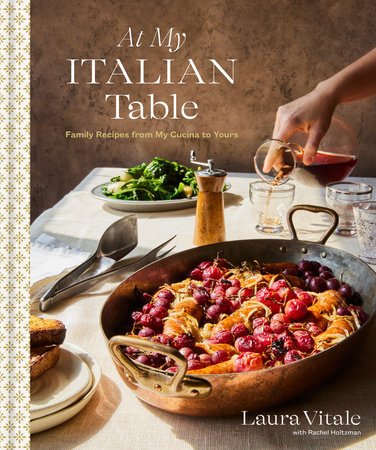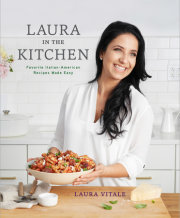IntroductionGrowing up in Naples, Italy, I was taught from a very young age that to eat was not just to fill your belly. Food was meant to be something delicious and satisfying, to be sure, but it was also how Italians connected with one another, marked moments in time, or simply just
lived. There was the deep comfort of waking up in the morning and sipping a bowl of sweet zuppa di latte with my nonno, who had just gotten back from the docks, or sitting down to a steaming plateful of my nonna’s spaghetti aglio e olio after school—my paternal grandparents having helped raise me as though I was their own to help my young parents.
There was the buzz of excitement from everyone gathering at my namesake, Nonna Laura’s, for Sunday pranzo, all the cousins racing for the next fresh batch of cauliflower fritters coming out of the pan, then grazing for hours over bracioletti al sugo and zucchini parmigiana. On birthdays, it was the cherished honor of Nonna cooking your favorite meal
and dessert (pasta al forno, a side of broccoli rabe, and pastiera napoletana, forever and always). And when someone passed, it was walking with Nonna to drop off that family’s favorite cake of hers (usually her famous olive oil apple snack cake or fruit crostata), so they could savor something that brought them joy. “There is no answer that food doesn’t provide,” she would say.
The slab of tomato pie I’d grab from the bakery on my way to school, the paper bags of piping hot zeppole e panzerotti we’d munch as we walked home from the beach, the caprese that was on everyone’s table the minute the weather turned warm—these were the memories of my childhood. And when I think about them, I can certainly taste each and every one of those dishes—which is why their recipes are now in this book—but more than anything, I remember the way that each of these special moments touched my soul. And that’s exactly what saved me.
When I was twelve, I came to the States to visit my dad, who had been living in Philadelphia with his new wife. I was there to celebrate the birth of my twin half-siblings and was supposed to stay only through Christmas, but due to unforeseen circumstances, my parents felt it was best for me to remain indefinitely. What began as an extended vacation turned into a completely new way of life—a new family, a new house, not to mention a new language in a new country. While I knew that my dad would care for me, it felt like only a small solace compared with losing the warmth and security of my mother, Nonna, and Nonno. For a young child—for anyone, really—it was abrupt and difficult. I felt homesick for months, struggling to adjust and feeling lost and alone.
Then one afternoon, I was talking to my nonna—or sobbing, more like it—and I asked what she was cooking that day. “My Sunday sauce,” she said, which made me even more upset because in that moment, I could feel in the pit of my stomach how much I missed walking into her house on a Sunday morning and smelling the pot going on the stove. I told her that I was afraid I’d forget what it tastes like. To which she, very reasonably, said, “Why don’t you just make it?”
Me? Make Nonna’s Sunday sauce?! It seemed like such an outlandish suggestion to try to cook this sacred recipe, until she added, “I’ll teach you how.” I grabbed the nearest piece of paper—a PECO energy bill—wrote down everything she instructed, and I handed my dad a list of ingredients to buy at Pathmark. Then I followed each step, exactly as she described them—no easy task, seeing as the woman cooks from intuition more than precise measurements. But far from feeling overwhelmed, I was overcome with the familiarity of it all: spending the day in the kitchen helping my grandmother or mother or godmother or aunts or uncles prepare whatever it was that was to be for lunch or dinner (or just a snack to eat while cooking—a staple of the Italian diet, and one that gets its own chapter here); the comforting universal sameness of peeling garlic and chopping onions; and then there was the deep, savory aroma of the sauce as the aromatics, braising meats, and simmering tomatoes began to come together. For the first time in a long time, I was home.
When I realized that the only thing that helped me to not feel sad was cooking, I started cooking a whole lot more. I’d call my nonna in the morning to see what she was making that afternoon, and little by little, I re-created all the dishes I grew up with, where just one smell brought me back to happiness and security. From fagioli a zuppa (beans bathed in a tomato and basil broth) to eggplants marinated in oil and vinegar with tons of garlic, I cooked my little heart out every single day. By the time I was fifteen, I had started working in my dad’s pizzeria, where I could make a little money doing something that made me feel whole. As a teen, I loved whipping up treats for my friends. And by my early twenties, when I was newly engaged and living with my now-husband, Joe, I was known as the girl who made giant batches of meatballs every Sunday and everyone would drop by unannounced knowing they would have plenty to snack on while watching football. Joe’s family and our friends quickly learned that the place to have celebratory or holiday meals—or any meal, let’s be honest—was at our house. And ever since the birth of our daughter, Mia, I’ve made sure that she knows that no matter how special or disappointing her day has been, there will be something delicious to preserve that moment into memory or to help it pass less painfully.
People always ask me when I knew that I wanted to cook for a living. And the truth is, never. I always thought I’d be a hairstylist or a makeup artist. But the reality is that cooking showed up for me when I needed something to hang on to. And ever since that moment in my life, I’ve made it my mission to share the power that food has to ease the difficult times and forever cement the good ones as memories. Whether it’s lugging my electric skillet (page 20) to the garage because it’s raining but my little sister just got dumped and needs her favorite eggplant and chicken cutlets, or making a pot of pastina in brodo for Mia because it’s her favorite after-sledding meal, or sending my recipes out into the world so people can share them with their own families and create their own special moments, these are the reasons why I do what I do—because I know how these dishes, and the intentions behind them, make people feel. And because ultimately, life is made up of a collection of little things that bring us joy every day, and I’m going to celebrate the heck out of each and every one.
At My Italian Table is exactly what is sounds like—it’s all the recipes you need to capture the essence of what I think makes Italian meals so special. They’re the simple staples made from the season’s most anticipated ingredients that you can cook and enjoy over and over again because they never get old, that can be mixed and matched, that never apologize for needing only a good, crusty loaf of bread to make a complete dinner, and that rarely require more than one pot or pan, a few pantry items, and a little bit of hands-on time. They are the recipes that you reach for both when you want a satisfying and comforting but quick-to-come-together meal at the end of a long day, as well as those days when you have a little more to celebrate, or a little more time to savor in the kitchen.
I should know; these are the dishes from my everyday, very real (very Italian) life. (I jokingly call my house Villa Vitale because how we eat and live is like a slice of Italy in South Jersey.) That’s something that means a lot to me and has come to mean a lot to my extended social media family. Every morning when I wish my online community a “Buongiorno” or “Good Morning”—which has become such a ritual that if I don’t do it, I get thousands of messages wondering if I’m okay—it’s in the spirit of sharing things from my life as genuinely and realistically as possible. These recipes are no exception. People sometimes think we Italians can’t call it a meal unless it has fourteen courses. Sure, come over on Christmas Eve or Easter and I’d say you’re probably right. But on a Monday? Not even close! I grew up watching my nonna—an Italian if ever there was one—setting out effortless meal after effortless meal using no more than five or six ingredients to create a beautiful dinner or lunch. There’d be bread on the table, some wine for Nonno, and maybe some fruit for dessert. But ultimately, simplicity was queen. Dinners, especially on a weeknight, don’t need to be three-course meals. No one’s got time for that! And no one’s expecting that. Show me a kid who misses having sides with their pasta! No, when you’ve got a nourishing, delicious dish at the center of a meal, it IS the meal. One and done. That’s exactly how I’m cooking for my own family week after week, and it’s the same recipes you can now reach for depending on your mood, your preferences, and your time.
Copyright © 2024 by Laura Vitale with Rachel Holtzman. All rights reserved. No part of this excerpt may be reproduced or reprinted without permission in writing from the publisher.














